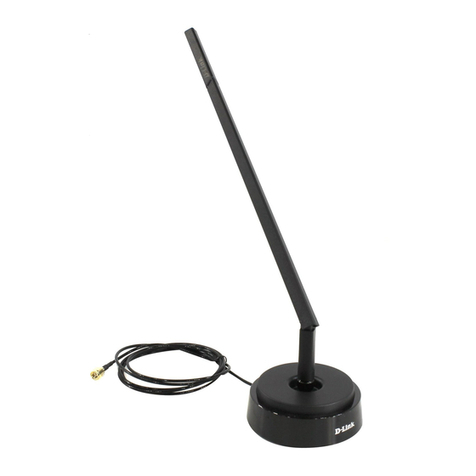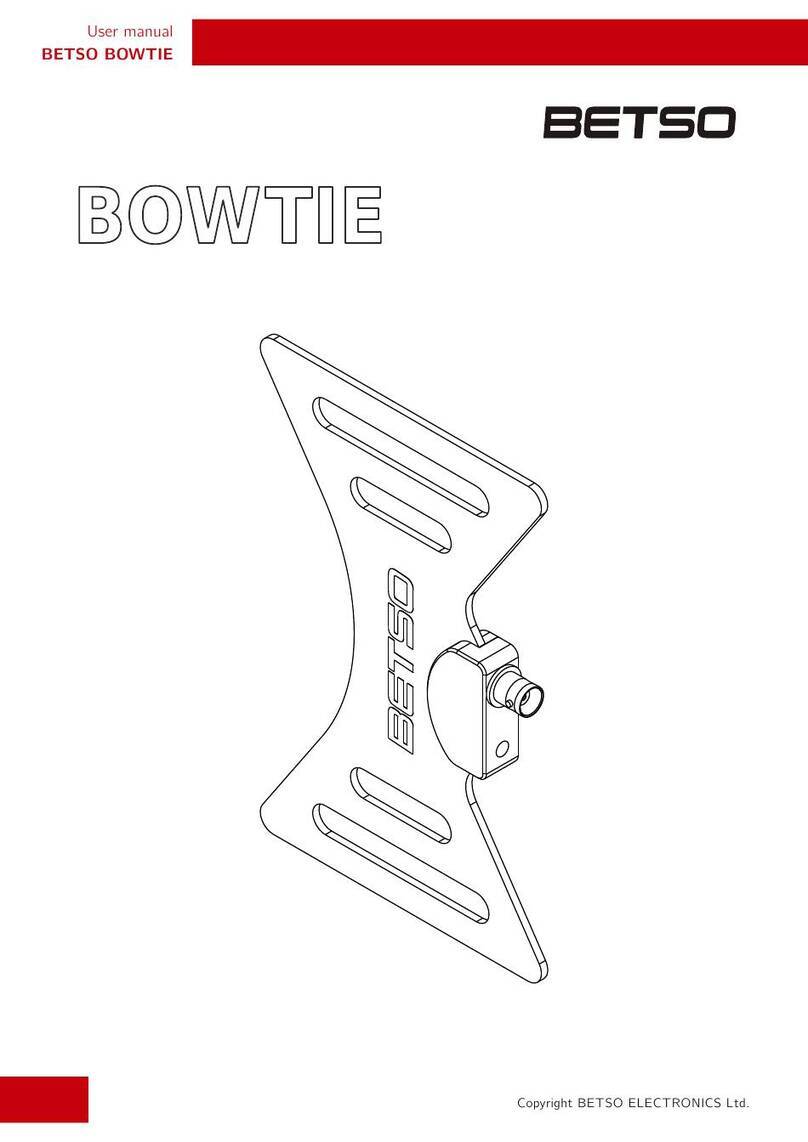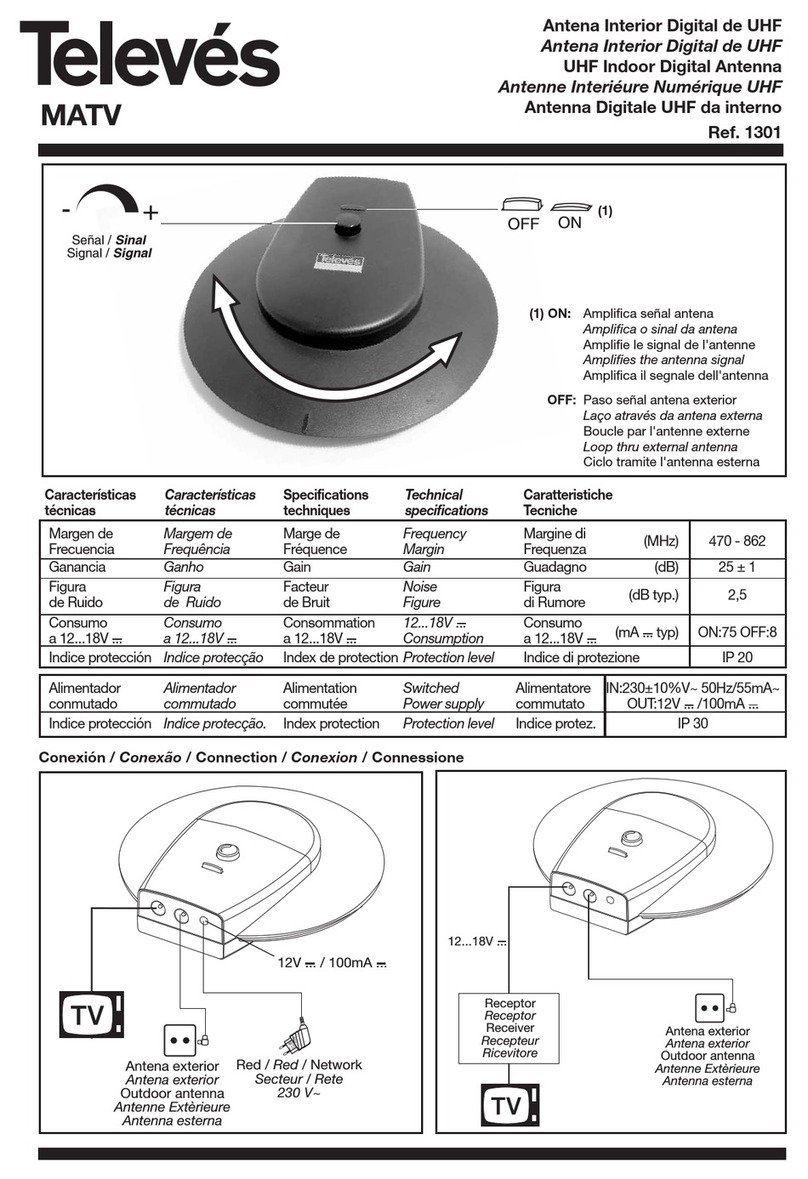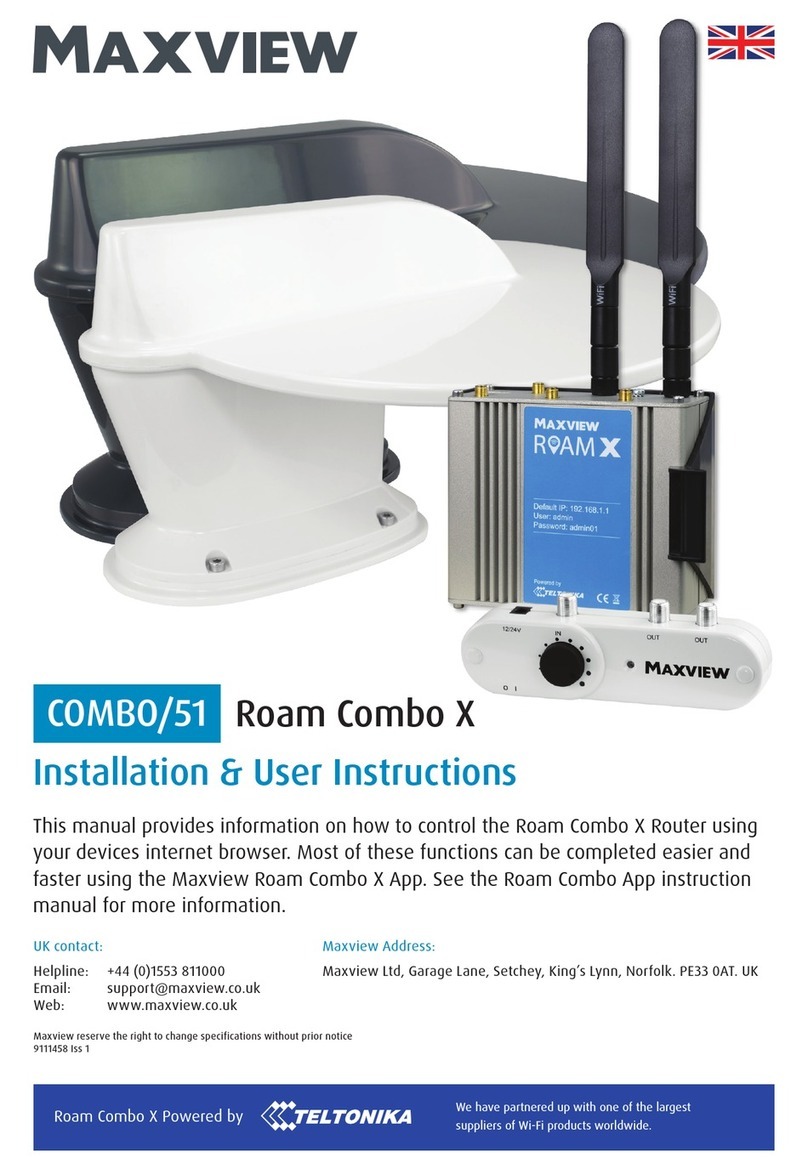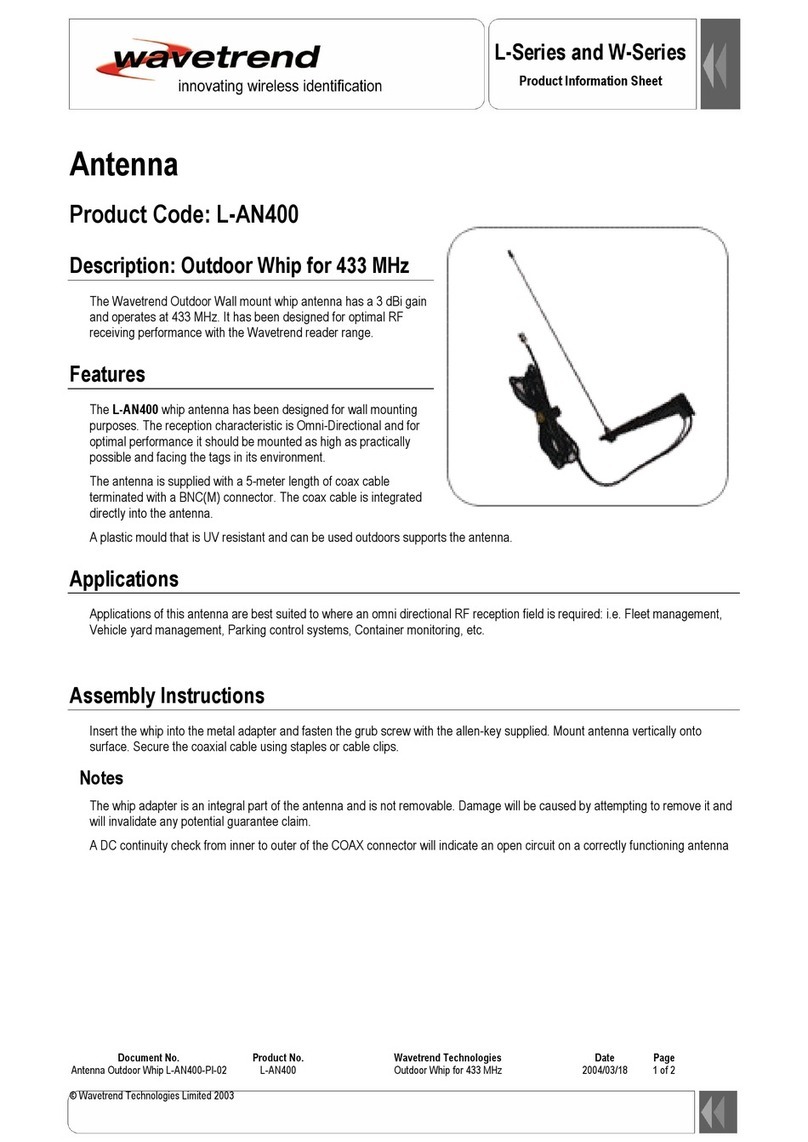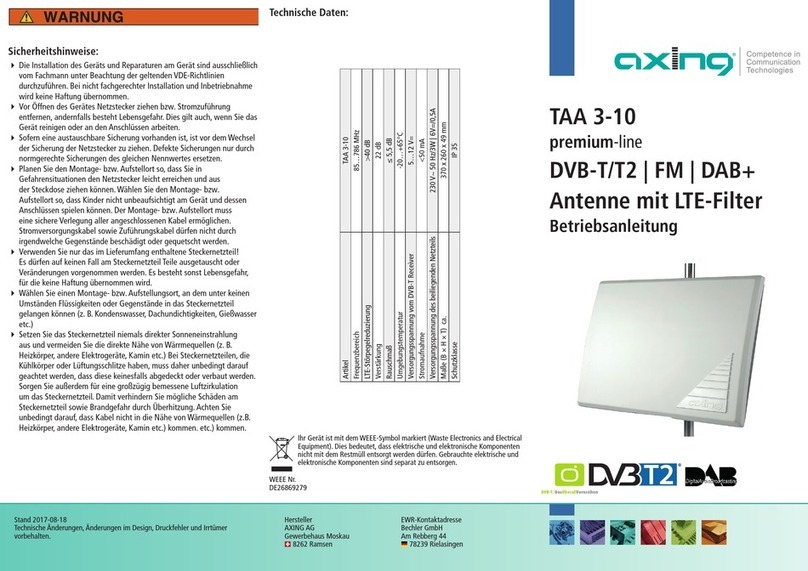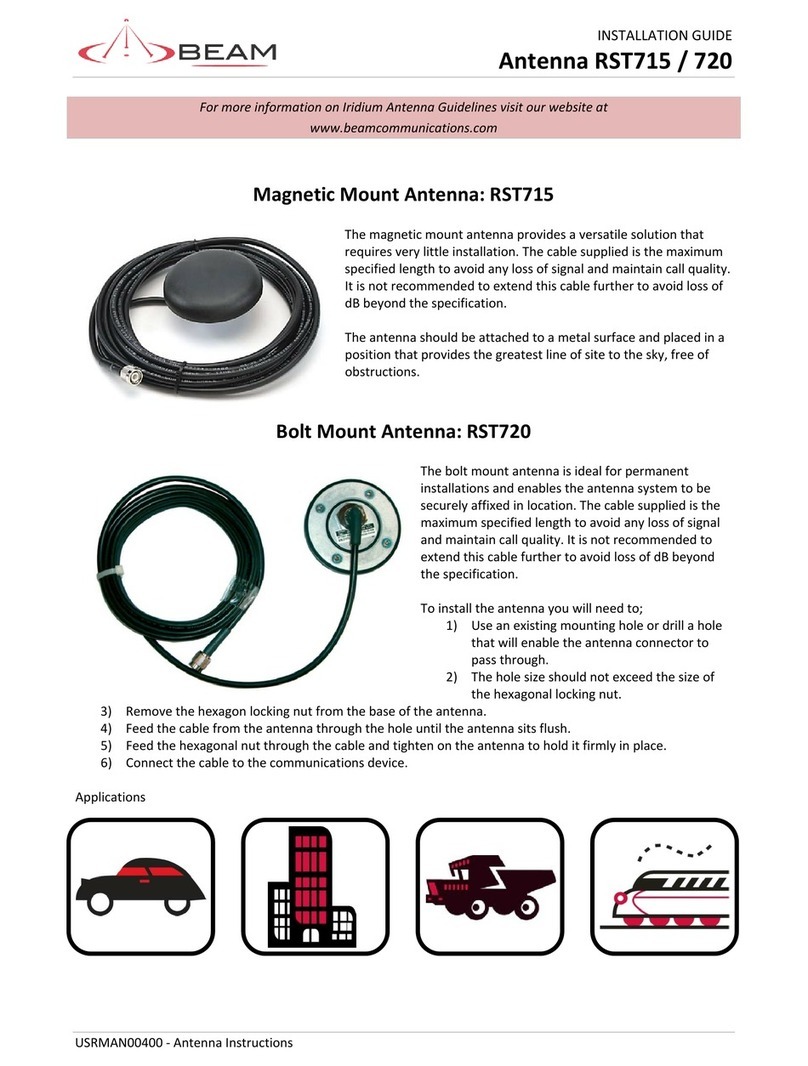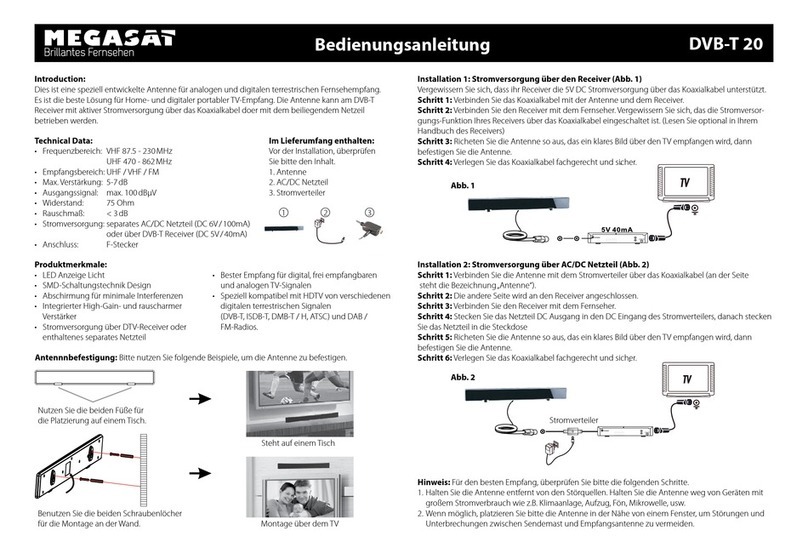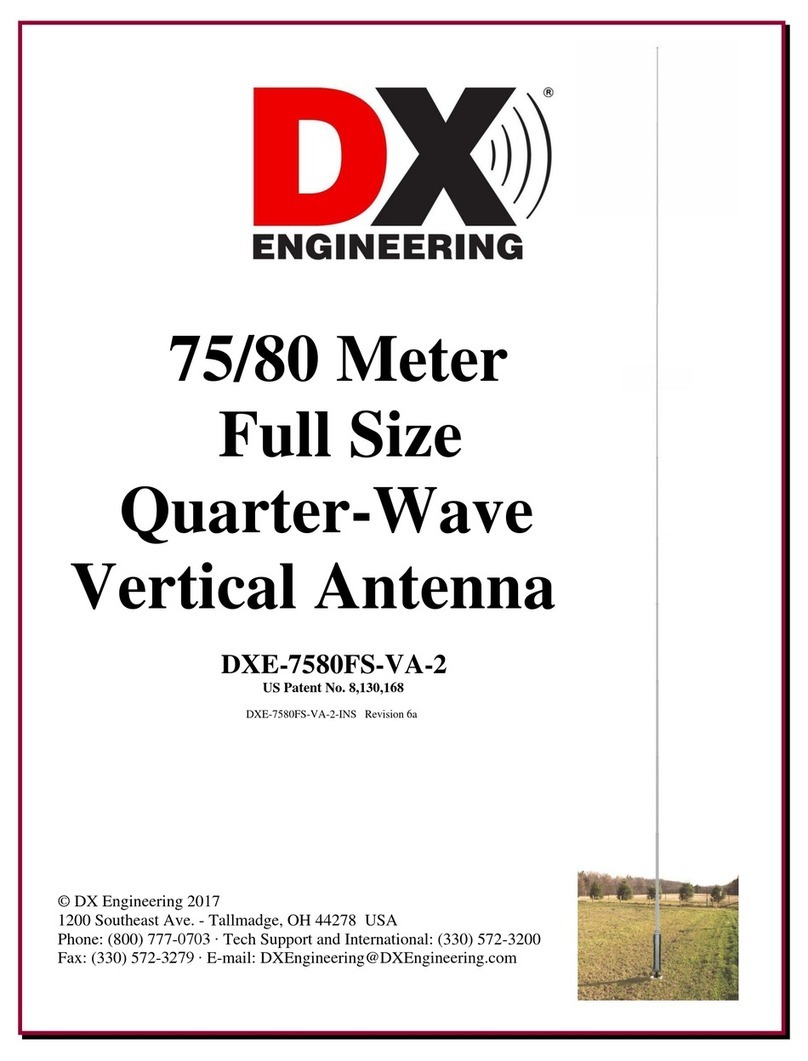BrasilSat SCB37-120 User manual

I
MANUAL FOR
MODELS:
SCB37-120
SCB107-120
SCB107E-120
12 METERS CASSEGRAIN EARTH STATION ANTENNAS

I
C o n t e n t
1 General………………………………………………………………………………...2
2 Technical Specifications………………………………………………………………3
2.1 Specifications of the model SCB37-120…………………………………………….3
2.2 Specifications of the model SCB107-120…………………………………………...4
2.3 Specifications of the model SCB107E-120………………………………………….5
3 Structural Character and Operational Principle………………………………………..6
3.1 System Structural Character...................................................................…..................6
3.1.1 Antenna Structural Character..………………………………………….……….7
3.1.2 Antenna Pedestal Structure…..…………………………………………………13
3.1.3 Feed Structure…..………………………………………………………………17
3.2 Antenna Operation Principle..................................................................................... 19
4 Maintenance..............................................................................................................….19
4.1 Operation and Maintenance of Antenna.............…............ .....................…............. 19
4.2 Operation and Maintenance of Servo Equipment......................................…............ 22

2
1 General
The 12m antenna, a synthetic Cassegrain dual-reflector antenna models SCB37-120,
SCB107-120 and SCB107E-120, adopts some new technologies, such as high-
performance corrugated horn and broadband microwave network, etc.
The antenna performance meets the requirements of ITU-R/ITU-T、INTELSAT IESS-207
and Resolution 572 of Anatel standards. It is not only provided with many excellent
electric performances, such as high efficiency, low sidelobe, low cross polarization, low
Voltage standing waves ratio (VSWR), high G/T value, but also with excellent characters
including appropriate structural design, strong wind resistance ability, beautiful
appearance and high tracking accuracy. It is a new generation satellite communication
antenna.
This manual is applicable for the follow models of antenna:
SCB37-120: C-Band Cassegrain 12 meters antenna for Circular or Linear Polarization;
SCB107-120: Ku-Band Cassegrain 12 meters antenna for Linear Polarization;
SCB107E-120: Extend Ku-Band Cassegrain 12 meters antenna for Linear Polarization;

3
2 Technical Specifications
2.1 Specifications of the model SCB37-120:
Electrical Performance
Rx 3625 to 4200 MHz
Frequency Range Tx 5850 to 6425 MHz
Polarization Linear or Circular
Rx 52,2 dBi (@ 4,00 GHz)Gain
(Including Losses) Tx 55,7 dBi (@ 6,00 GHz)
Rx 0,5º (@ 4,00 GHz)
Half-power Beamwidth Tx 0,3º (@ 6,00 GHz)
10º El 42 K (@ 4,00 GHz)
20º El 36 K (@ 4,00 GHz)
Noise Temperature 30º El 33 K (@ 4,00 GHz)
Typical G/T, 20º elevation at clear Sky
with C Band LNA, 30 K 33,8 dB/K (@ 4,00 GHz)
Anatel Resolution 572
FCC regulation 25.209
Radiation Pattern Envelope ITU-RS580
Rx 1.06 (0,5 dB)Axial Ratio
(Circular Configuration) Tx 1.06 (0,5 dB)
Rx 35 dBCross Polarization Discrimination
(Linear Configuration) Tx 35 dB
Rx 1.3 (17.7 dB)
VSWR (Return Loss) Tx 1.3 (17.7 dB)
TX/RX 75 dB
Port to Port Isolation RX/TX 55 dB
Rx CPR 229G
Feed Termination (flange) Tx CPR 137 G
Input Maximum Power 2000 W
Mechanical Characteristics
Diameter 12 meters
Antenna Geometry Cassegrain
Motion Elevation over azimuth
Azimuth ± 90º
Elevation 0 a 90º
Motion Adjustment Polarization ± 50º
Reflector Material Aluminum
Mount Material Steel
Reflector White painting
Finishing Mount Hot dip galvanized
Surface Precision 0.5mm (RMS)
Environmental Characteristics
Operational Wind 130 km/h
Survival Wind 198 km/h
Shock and Vibration Typical in sea, air and terrestrial shipments
Atmosphere Found in seashore and industrial areas

4
2.2 Specifications of the model SCB107-120:
Electrical Performance
Rx 10700 to 12750 MHz
Frequency Range Tx 13750 to 14800 MHz
Polarization Linear
Rx 61,7 dBi (@ 12,00 GHz)Gain
(Including Losses) Tx 63,0 dBi (@ 14,00 GHz)
Rx 0,13º (@ 12,00 GHz)
Half-power Beamwidth Tx 0,11º (@ 14,00 GHz)
10º El 60 K (@ 12,00 GHz)
20º El 50 K (@ 12,00 GHz)
Noise Temperature 30º El 46 K (@ 12,00 GHz)
Typical G/T, 20º elevat
ion at clear Sky
with C Band LNA, 60 K 40,9 dB/K (@ 12,00 GHz)
Anatel Resolution 572
FCC regulation 25.209
Radiation Pattern Envelope ITU-RS580
Rx 35 dB
Cross Polarization Discrimination Tx 35 dB
Rx 1.3 (17.7 dB)
VSWR (Return Loss) Tx 1.3 (17.7 dB)
TX/RX 75 dB
Port to Port Isolation RX/TX 55 dB
Rx WR 75
Feed Termination (flange) Tx WR 75
Input Maximum Power 1000 W
Mechanical Characteristics
Diameter 12 meters
Antenna Geometry Cassegrain
Motion Elevation over azimuth
Azimuth ± 90º
Elevation 0 a 90º
Motion Adjustment Polarization ± 50º
Reflector Material Aluminum
Mount Material Steel
Reflector White painting
Finishing Mount Hot dip galvanized
Surface Precision 0.5mm (RMS)
Environmental Characteristics
Operational Wind 130 km/h
Survival Wind 198 km/h
Shock and Vibration Typical in sea, air and terrestrial shipments
Atmosphere Found in seashore and industrial areas

5
2.3 Specifications of the model SCB107E-120:
Electrical Performance
Rx 10700 to 12200 MHz
Frequency Range Tx 12750 to 14500 MHz
Polarization Linear
Rx 61,3 dBi (@ 11,45 GHz)Gain
(Including Losses) Tx 62,7 dBi (@ 13,50 GHz)
Rx 0,16º (@ 11,45 GHz)
Half-power Beamwidth Tx 0,13º (@ 13,50 GHz)
10º El 60 K (@ 11,45 GHz)
20º El 50 K (@ 11,45 GHz)
Noise Temperature 30º El 46 K (@ 11,45 GHz)
Typical G/T, 20º elevation at clear Sky
with C Band LNA, 60 K 40,4 dB/K (@ 11,45 GHz)
Anatel Resolution 572
FCC regulation 25.209
Radiation Pattern Envelope ITU-RS580
Rx 35 dB
Cross Polarization Discrimination Tx 35 dB
Rx 1.3 (17.7 dB)
VSWR (Return Loss) Tx 1.3 (17.7 dB)
TX/RX 75 dB
Port to Port Isolation RX/TX 55 dB
Rx WR 75
Feed Termination (flange) Tx WR 75
Input Maximum Power 1000 W
Mechanical Characteristics
Diameter 12 meters
Antenna Geometry Cassegrain
Motion Elevation over azimuth
Azimuth ± 90º
Elevation 0 a 90º
Motion Adjustment Polarization ± 50º
Reflector Material Aluminum
Mount Material Steel
Reflector White painting
Finishing Mount Hot dip galvanized
Surface Precision 0.5mm (RMS)
Environmental Characteristics
Operational Wind 130 km/h
Survival Wind 198 km/h
Shock and Vibration Typical in sea, air and terrestrial shipments
Atmosphere Found in seashore and industrial areas

6
3 Structural Character and Operational Principle
3.1 System Structural Character
The 12m limit-motion antenna system is composed of antenna feed subsystem and
structure subsystem. The antenna feed subsystem contains feed and main reflector and
subreflector curves. The structure subsystem contains main reflector and subreflector,
polarization rotation device, pedestal and antenna feeder. The composition principles of
antenna system are shown in Fig.3.1-1. The picture is shown in Fig.3.1-2.
Fig.3.1-1 Composition Principle Block Diagram of Antenna System

7
Fig.3.1-2 Picture of 12m antenna
3.1.1
Antenna Structural Character
3.1.1.1
Antenna Reflector Assembly
The antenna reflector is mainly composed of main reflector, subreflector,
backups, subreflector supporting device, feed sleeve, etc. The three-dimensional
forming diagram is shown in Fig.3.1-3.
Fig.3.1-3 Structural Schematic Diagram of 12m Antenna

8
3.1.1.2
Main Reflector Design
The main reflector is one of the core components of the antenna system. Its theoretical
curved surface is formed by synthetic curve rotating around the axis of the antenna.
The antenna reflector is divided into multiple plates because of cumulative materials,
manufacturing engineering, final assembly adjustment, etc. The reflector is divided into
three rings. Inner ring reflector is divided into 16 same sector unit plates; the middle
ring is divided into 32 sector unit plates and the outer ring is divided into 32 sector unit
plates. So the main reflector of antenna is composed of 80 reflector units, as shown in
Fig.2.1-4 and 2.1-5.
Fig.2.1-4 Structure Diagram of Antenna Main Reflector
Fig.2.1-5 Individual Sector Plate Structure Schematic Diagram of Outer Ring

9
The stretched and shaped 2A12-O aluminum board with thickness of δ=2mm is used as
individual sector plate after quenching, stretching and shaping. Z type aluminum casting
material is used as back rib after quenching, stretching and shaping in order to perform
positioning with rivet the die table for riveting rib and reflector. Each sector plate is
supported at backups via 6 stretching bolts. In order to ensure the process precision, such
process technology as first bonding and second riveting is adopted to improve the
strength of individual plate and reduce the number of rivets and thus decrease the local
deformation of plate caused by riveting points. The high precision mould and tool set up
process are used for all procedures, such as stretching, stretch bending, riveting. The
accuracy of the individual plate is ≤0.15mm (R.M.S). The reassembly precision of
whole main reflector is ≤0.45mm (R.M.S).
3.1.1.3
Subreflector and Its Supporting Mechanism Design
The subreflector is made of aluminum casting material and adopts the integral structure. It
is manufactured with the numerically controlled machine tool to ensure its precision,
which is not more than 0.15mm (R.M.S). The subreflector supporting mechanism is
composed of four support rods and one adjustment mechanism. In order to reduce its
shadow to the main reflector and ensure the supporting rigidity, the subreflector support
rod adopts the flat oval steel tube, of which one end is supported at the main backups and
the other is connected with the subreflector through adjusting mechanism. The four
adjusting bolts of adjusting mechanism are used to implement the adjustment of
subreflector axial movement, lateral movement and drift angle. The three-dimensional
forming diagram of subreflector and its supporting mechanism is shown in Fig.3.1-6.

10
Fig.3.1-6 Three-dimensional Forming Diagram of Subreflector and Its
Supporting Mechanism
3.1.1.4
Reflector Backups Design
The backups are the main stressed component and structural support of the whole
antenna reflector. It adopts space reticular truss structure, of which various structural
parts have such advantages as goodish consistency, smooth stress transmission, uniform
stress, favorable manufacture and installation, etc. and are widely applied because of the
higher rigidity-weight ratio.
The backups consist of the HUB, radiating beams and hoop stress bars and diagonal bars.
It is divided 32 pieces of main radiating beams along circumferential direction, a space
pull bar is laid between two radiating beams. The diagonal bars are laid between the outer
surface radiating beams. The previous bars parts constitute the space reticular truss
structure, as shown in Fig.3.1-7.

11
Fig.3.1-7 Reflector Backups Schematic Diagram
The HUB is the basic stressed component in the antenna structure and also the
connection component between the antenna reflector and antenna pedestal. All loads of
antenna reflector are down-transferred concentratively through the HUB. So the
HUB must have higher rigidity.
The appearance design of HUB is tapering barrel type, the bottom diameter is φ4300mm,
the height is 1300mm, the coning angle is 76°. The tapering barrel is made of steel plate
(t=8), the top and bottom (t=10) are seal-welded with flange. 28 heterotypic ribs are in the
corresponding positions of the HUB and radiating beams. One ring and two rings
of concentric circular rib plates with the height of 200mm are respectively at the top and
the bottom, so the cellular structure is formed in the whole HUB to make it have
maximum rigidity. The polyphenyl heat insulating material with thickness of 50mm is
stuck in the tapering barrel of HUB to constitute the high frequency room after built-in of
fireproofing decorative plates for installation of general equipment and high
frequency receiving components, of which minimum available volume is φ2800×1200
and which has larger and comfortable environment space. In order to meet the
requirement of transportation, the HUB is designed as bilateral symmetry connection
type, the thickness of connection steel plate is 16mm, the material type is Q235A, the
fastener is M20 high intensity bolt, as shown in Fig.3.1-8.
The radiating beams is one of the main stressed components in the antenna reflector
space reticular truss structure. It is the planar truss constituted by top boom, low boom,
normal web member and diagonal web member through spherojoint welding. Its main

12
role is to form the supporting back bracket of the main reflector of antenna with
hoop stress pull bar and diagonal draw bar. The top boom and low boom are made of
20# steel material and they are seamless steel tubes with size of φ 57 × 3. The
normal web member and diagonal web member are made of 20# steel material and they
are seamless steel tubes with size of φ50×3. Their characteristics are simple type,
uniform stress, high rigidity and convenient surface treatment, as shown in Fig.3.1-9.
Fig.3.1-8 Schematic Diagram of HUB
Fig.3.1-9 Schematic Diagram of Radiating
Beams
The hoop stress pull bar is the steel pole fitting of φ50×3. The 3 hoop stress pull bars
and diagonal draw bars are connected from beginning to end to the outer end of the
radiating beams to play the role of hoop stress stabilization for the reflector framework.
The material is 20# steel.

13
3.1.1.5
Feed Sleeve
The feed sleeve is the supporting component of feed network, which is divided into two
segment such as upper segment and lower segment. Both are formed through rolling and
welding of Q235A steel plate with thickness of 4mm. The lower segment uses circular
sleeve structure and moving sleeve design, microwave network is installed in the
moving sleeve, which performs moving connection with fix sleeve through two thin
wall bearing, the fix sleeve is fixed in the HUB. The upper segment uses tapering sleeve
structure, of which the upper end surface performs positioning connection with
corrugated horn and the lower end surface performs positioning with the rabbet of
moving sleeve and the flanges are connected with bolts. So, the linear polarization
direction of feed network can be adjusted only by rotating moving sleeve for
implementing linear polarization surface adjustment which uses electric mode.
3.1.2
Antenna Pedestal Structure
The antenna pedestal is mainly used to provide the support for the antenna, and make
the antenna perform the azimuth and elevation rotation and align the satellite accurately
under the control of servo equipment. The antenna pedestal adopts the columnar beams
type pedestal structure, namely A, E two axes type pedestal, it consists of pedestal,
azimuth-elevation driving, synchronization and limit devices, platform ladder,
etc. The structural three-dimensional modeling view is shown in Fig.3.1-10.

14
Fig.3.1-10 12mAntenna Pedestal 3D Modeling View
Its azimuth driving mechanism is below columnar beams and the elevation driving
mechanism is postposition type. The whole antenna pedestal is seated on five reinforced
concrete bases.
3.1.2.1
Azimuth Part
The azimuth part consists of the azimuth-elevation supporting combination, tripod,
azimuth lower bearing pedestal combination, azimuth upper bearing pedestal combination,
etc.
The azimuth-elevation supporting combination is a T-type combination constituted by the
kingpost and the tripod. The kingpost with Ф900mm and length of 3.45m is decumbent on
the previous one. The tripod is constituted with three inclined struts that their upper
ends are converged at one point. The lower ends of the three inclined struts are fixed at
the base with bolts, and the upper ends are connected to the azimuth upper bearing
pedestal combination and fixed at the intersection point of their center connecting lines to
form the upper axle head for azimuth rotation. The lower bearing pedestal combination is

15
fixed at the base with bolts, the centers of the upper and lower bearing are at the same
plumb line and form the azimuth axis.
The annular contact thrust spherical-roller bearing 9069332 is installed in azimuth lower
bearing pedestal, the knuckle sliding bearing is installed in azimuth upper bearing pedestal.
The upper and lower axle heads are respectively installed into the upper and lower
rotation axle pedestal holes. In this way, the azimuth-elevation bearing combination can
perform azimuth movement under the role of the azimuth driving device, the azimuth
travel range is within ±90º.
3.1.2.2
Elevation Part
The elevation part mainly consists of the azimuth-elevation bearing combination,
driving pedestal E, elevation bearing pedestal combination, etc.
On the support arms at the two sides of decumbent cylinder at the top of azimuth-
elevation bearing combination, there is a pair of axle holes orthogonal with the azimuth
axis, in which are the bearings. The two axle holes connect the elevation bearing pedestal
combination with the decumbent cylinder via the clevis pin with head to form the
elevation axis E. In this way, the antenna can perform the elevation movement under the
role of elevation driving device. The elevation rotation range is within 0º~90º.
3.1.2.3
Driving Device
The driving device consists of the elevation driving device and azimuth driving device.
The driving device composition block diagram is shown in Fig.3.1-11. The azimuth and
elevation driving devices are lead screw type. The decelerator of driving device
adopts SG-71 type plane secondary envelope worm pair. The decelerator adopts cycloid
pin wheel decelerator and planetarygear decelerator.
Fig.3.1-11 Driving Device Composition Block Diagram

16
AC motor: select and use double-speed AC motor, the type number is YD160L-16/4H
(horizontal type), it is the sealed type three-proof motor, normal power is 2KW/8KW;
rotating speed is 361r/min/1460r/min,the azimuth and elevation motor are same.
Elevation decelerator: planetary gear decelerator, the type number is NGW11-9
(horizontal type), deceleration ratio: i=7.1.
Azimuth decelerator: cycloid pin wheel decelerator, the type number is XW5.5-5-1/9,
deceleration ratio: i=9.
Worm gear-worm pair: SG-71-type plane secondary enveloping surface torus worm pair,
the worm is single-head type, deceleration ratio: i =40, the azimuth and elevation
worm gear- worm pairs are same.
Leadscrew-nutpair:thescrewthreadparameterisTr150X14,theazimuthandelevationleadscrew-nutpairs
aresame.
The final stage of driving chain is lead screw-nut pair, which has self-locking capability.
The antenna can apply the brake safely at any position and at the same time the nut pair
use double nuts for backlash elimination.
3.1.2.4
SynchronizationDevice
The azimuth and elevation synchronization devices are respectively installed on the
azimuth and elevation axle heads, the corners of axis is transformed into the electrical
signals and output to obtain the position information of antenna.
3.1.2.5
Limit Device
In order to make the antenna rotate within the safe range, install safe limit protection
device on the azimuth and elevation axle heads of antenna to make the antenna operate
safely.
The limit device consists of the limit switch and mass. The limit swicths are respectivily
installed on the two extreme positions of travel range of azimuth and elevation axes, when
the antenna travels the extrem position and the mass touches switch, the power supply is
switched off.
3.1.2.6
Platform and Ladder
For the convenience of maintenance and ensuring safeguard, the guardrail, ladder
and platform are installed on the antenna pedestal.

17
3.1.3
Feed Structure
The feed is the core of the whole antenna and its performances directly affect the RF
performance of the antenna. So the optimized scheme and design should be performed
more carefully. The feed is composed of corrugated horn and microwave network.
3.1.3.1
Corrugated Horn
Rx and Tx singles of the antenna share the same corrugated horn. It’s required to
realize ideal radiation at the Rx and Tx bands, with rotary symmetry and low cross
polarization radiation pattern and low VSWA characteristic.
The corrugated horn consists of input taper section, mode converter section,
transition section and output flare section. The transition section may include
frequency transition section and angle transition section. If the frequency band is
narrow, there is no frequency section. The principle block diagram is shown in Fig.3.1-
12. The purpose of the mode converter section is to well convert the main mode TE
11
in
the circular waveguide into the main HE
11
in the corrugated waveguide, at the same time,
maintain good match and reject the generation of the harmful high order mode EH
12
. The
transition section is to accomplish the transition of frequency and the angle between the
mode converter section and the output flare section, at the same time, reject the
generation of the harmful high order mode EH
12
. The output flare section is to generate
the required subreflector brim illumination level. The mode converter section is the key
design. The ring-loaded slots in the mode converter section are adopted to expand the
frequency band. The structural figure of the whole horn in C-band and Ku-band is shown
in Fig. 3.1-13 and Fig. 3.1-14, respectively.
Fig. 3.1-12 Corrugated Horn Block Diagram

18
Fig. 3.1-13 Structural figure of corrugated horn in C-band
Fig. 3.1-14 Structural figure of corrugated horn in Ku-band

19
3.2 Antenna Operation principle
The C-band or Ku-band 12m Cassegrain antenna can be supplied with two ports (RX/TX) or
four ports (2TX/2RX). The operation principles are described as follows.
Antenna receiving principles:the antenna aligns satellite, the satellite signals are transmitted
via main reflector and subreflector to the feed, then output from the corresponding port of
feed and finally sent to the tracking receiver after LNAamplification.
Antenna transmitting principles: the transmitting signals are sent from HPA to the feed via
waveguide and radiated by the feed, then reflected to the free space via main reflector and
subreflector of antenna and propagated to satellite.
The antenna can simultaneously transmit and receive electromagnetic wave signals. The
step tracking mode (optional) is used to make the antenna be able to align the satellite.
4 Maintenance
As outdoor equipment, the antenna is exposed to natural environment such as wind, rain and
sun. The life of the equipment is greatly affected by correct operation and maintenance.
High-quality maintenance in time is very important to guarantee the service life of the
equipment.
To ensure the service life of the outdoor equipment, follow the requirements described below
for operation and maintenance.
4.1 Operation and Maintenance of Antenna
a) Pay attention to the local weather forecast. When strong wind higher than 32m/s is
coming, make preparations in advance so as to lock the antenna toward the sky with pin
at any time.
b) Once the subreflector has been installed and adjusted well and put into use, nobody is
allowed to go up onto the subreflector support. If it is necessary to go onto it for
maintenance, it is prohibited to step on the subreflector to prevent the installation
accuracy of the subreflector from being changed.
This manual suits for next models
2
Table of contents
Other BrasilSat Antenna manuals
Popular Antenna manuals by other brands
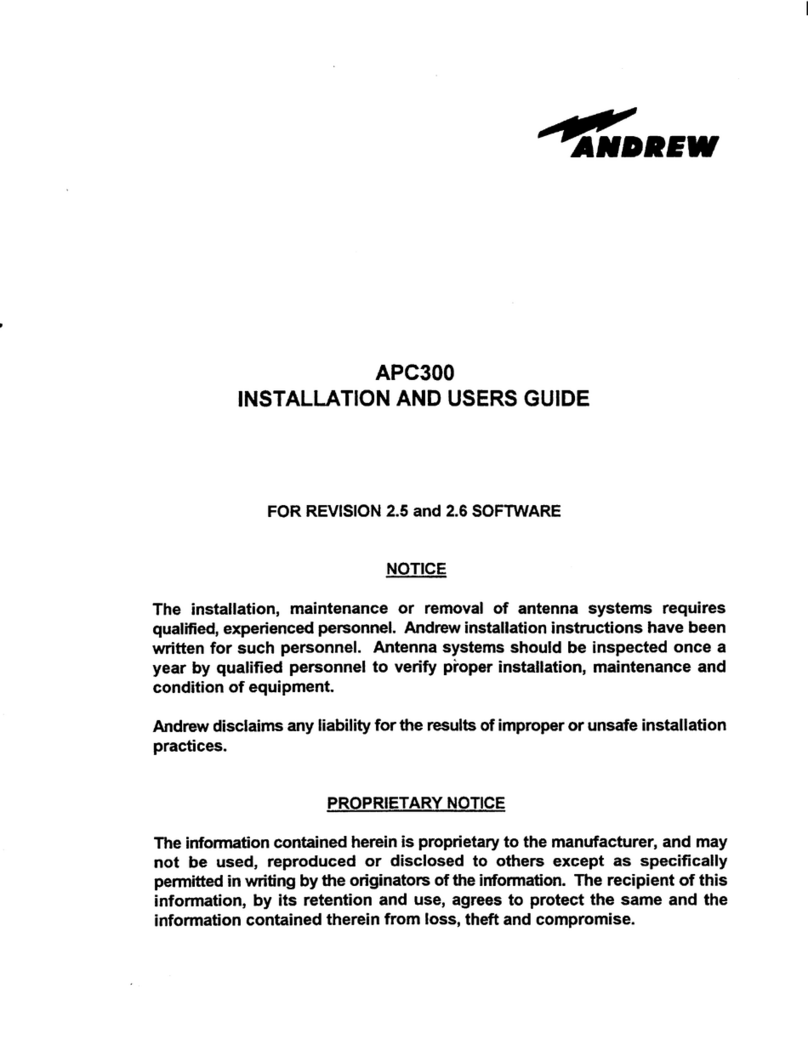
Andrew
Andrew APC300 Installation and user guide

Dielectric
Dielectric TFU instruction manual
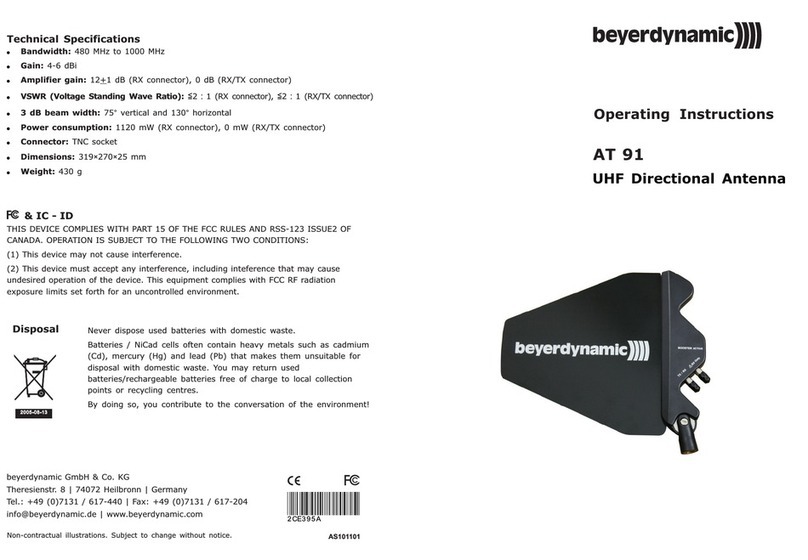
Beyerdynamic
Beyerdynamic AT91 operating instructions
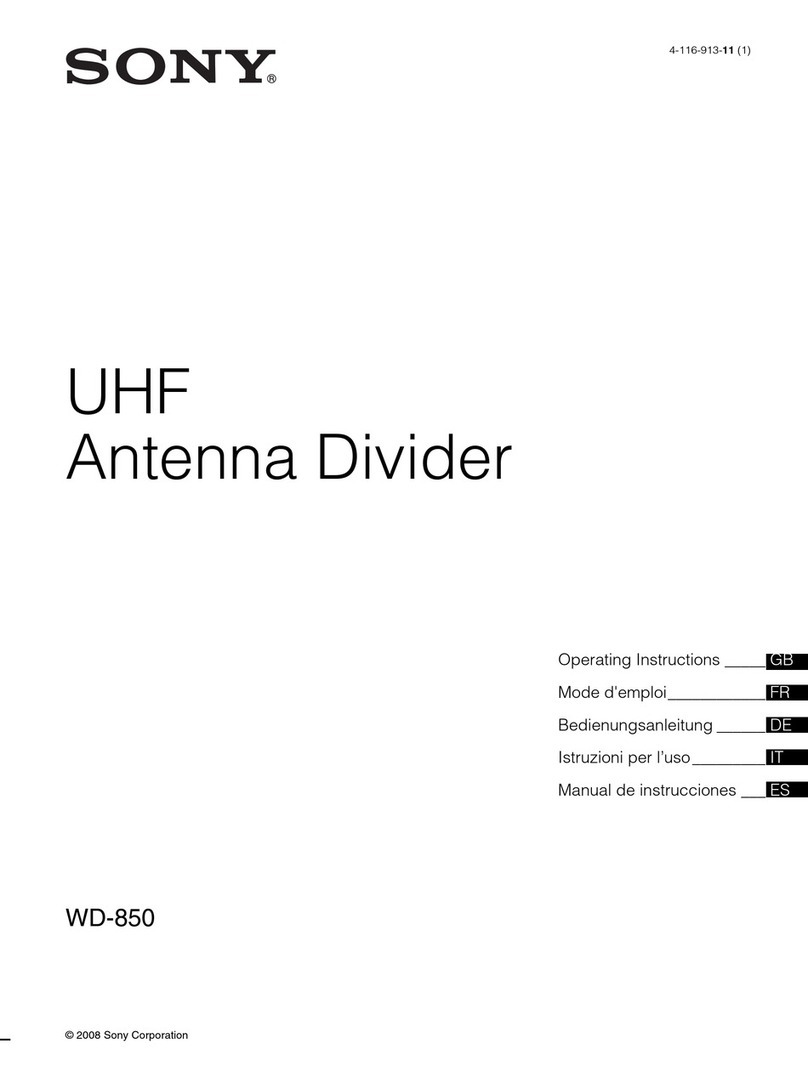
Sony
Sony WD-850 operating instructions
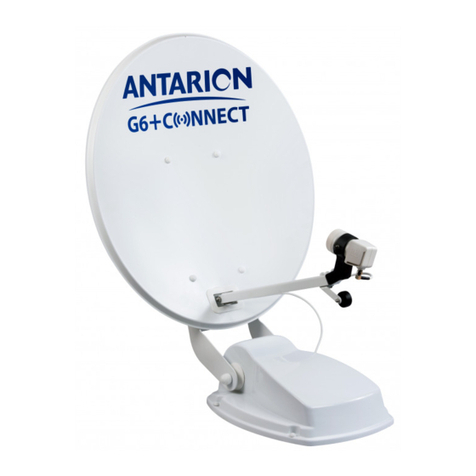
Antares
Antares ANTARION G6+ CONNECT installation manual
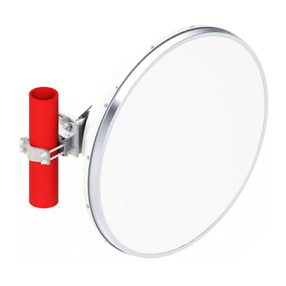
CommScope
CommScope ValuLine VHLP3 Series installation instructions




